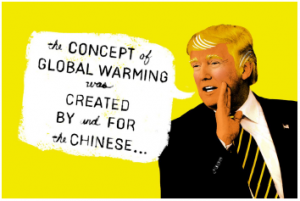As our climate changes, we tend to think about physical impacts to the environment, such as erosion or air pollution. We separate what is happening to the environment from ourselves to justify the detrimental impact that our current lifestyle generates. In reality, climate change directly impacts human wellbeing in many ways, including mental health. As our climate changes, weather patterns shift. Extreme changes in the weather destabilizes homes, which can impact physical and mental health. Research by Bourque and Wilcox (2014) provided evidence from specific weather events that have impacted psychological health. One of the weather pattern changes they studied was the drought in Australia that lasted nearly a decade. According to the prior research, the drought has been attributed to an increase in psychological distress causing anxiety and depression. The drought has greatly impacted the people whose life depends on the land, especially farmers. As they lose their crops due to the lack of water, their source of income dissipates. Many of the farmers reported feeling an “overwhelming sense of loss” because of losing their crops to the drought (Bourque & Wilcox, 2014). Furthermore, the Australian farmers have less access to mental health resources because of demographics and low income, making them more susceptible to psychiatric problems.
Indication that climate change has negatively impacted mental health can also be seen in the indigenous Inuit populations in Canada. Inuit life revolves around their natural environment. They use the land to sustain life through hunting and fishing, as well as many other activities that require the land. Beyond just sustaining life, the Canadian forests are their home, so you can imagine that losing their land could be equivalent to someone’s house burning down. The Inuit people are being directly impacted by climate change because of decreasing temperatures and an increased occurrence of storms that is destroying their home. This increased stress has been correlated with poor mental health. In fact, the suicide rates among the Inuit population are 11 times higher than the Canadian average (Bourque & Wilcox, 2014). Similar to the Australian farmers, the Inuit people also do not have proper access to mental health resources, which demonstrates the disparity climate change has on mental health in susceptible populations.
On a larger scale, climate change has increased the number of severe natural events, such hurricanes and floods, all over the world. Severe weather events can destroy homes and lives, which leads to acute stress. The elevated stress from these events is correlated with higher rates of PTSD and depression (Bourque & Wilcox, 2014). Specifically, flooding has been tied to high incidence psychological stress. In fact, a Dr. Onarae Rice at Furman University studies the relationship of dopamine pathway to PTSD in rats. In order to give the rats PTSD, one of the steps is to make the rat swim in water for an extended amount of time to simulate the feeling of drowning in a flood. Clearly, environmental disasters can directly impact mental health.
It is important that we help people who are experiencing the detrimental impact of climate change on their mental health. The first step is the acknowledge the correlation and inform people of it so that following a natural disaster people may be more likely to seek out mental health resources. It is also important that we have means for people to get counseling, since those who are the most susceptible to climate change impact most often don’t have resources. Of course, it is vital that we make changes to save our environment so that climate change does not progress.
-Olivia Larner
Bourque, F., & Cunsolo Willox, A. (2014). Climate change: The next challenge for public mental health? International Review of Psychiatry, 26(4), 415-422. doi:10.3109/09540261.2014.925851
 and environmental policy. President Trump stepped into the White House and quickly undid many of the actions taken by Obama toward curbing climate change and limiting pollution as well as other environmentally harmful acts; Following this, President Trump thus announced that the United States will no longer regard climate change by name as a national security threat, viewing it as nothing more than a “burden”for businesses.
and environmental policy. President Trump stepped into the White House and quickly undid many of the actions taken by Obama toward curbing climate change and limiting pollution as well as other environmentally harmful acts; Following this, President Trump thus announced that the United States will no longer regard climate change by name as a national security threat, viewing it as nothing more than a “burden”for businesses.

 Historically, homes and personal spaces have not been large. But around the 1960s, the size of American homes ballooned and continues to grow even now. In 1950 the average size of a new, single-family home was 983 sq. feet, in 1973 it had become 1660 sq. feet, and by 2015 it was 2598 sq. feet (Kilman, 2016; McLennan, 2010). For many, the sheer amount of space is unnecessary and uses many resources that would be better used elsewhere or conserved, such as the labor that goes into the building process, gas and energy being used as power, material resources, and time. These resources, combined with the size of a home, amount to a heavy bill and cause financial strain. This means that homeowners will spend more time trying to cover their bills month to month than saving or using their money for personal enjoyment and gain. This is why people have started to move in the opposite direction with their housing; they are choosing to go back to their roots and not live beyond their means.
Historically, homes and personal spaces have not been large. But around the 1960s, the size of American homes ballooned and continues to grow even now. In 1950 the average size of a new, single-family home was 983 sq. feet, in 1973 it had become 1660 sq. feet, and by 2015 it was 2598 sq. feet (Kilman, 2016; McLennan, 2010). For many, the sheer amount of space is unnecessary and uses many resources that would be better used elsewhere or conserved, such as the labor that goes into the building process, gas and energy being used as power, material resources, and time. These resources, combined with the size of a home, amount to a heavy bill and cause financial strain. This means that homeowners will spend more time trying to cover their bills month to month than saving or using their money for personal enjoyment and gain. This is why people have started to move in the opposite direction with their housing; they are choosing to go back to their roots and not live beyond their means.

 For the people more passionate about ocean life than trees, there are still options for a sustainable burial- Eternal Reefs. A similar concept to the Capsula Mundi, reef pods are created from human remains and an environmentally-safe cement mixture. These pods are then used to foster new habitats for sea life. There are currently 1800 Eternal Reefs created by people in the United States, but the company is quickly growing. Families can write in the concrete before it hardens and hold a service on the water as the reef pod is placed in a location of their choosing (“What is an Eternal Reef?”).
For the people more passionate about ocean life than trees, there are still options for a sustainable burial- Eternal Reefs. A similar concept to the Capsula Mundi, reef pods are created from human remains and an environmentally-safe cement mixture. These pods are then used to foster new habitats for sea life. There are currently 1800 Eternal Reefs created by people in the United States, but the company is quickly growing. Families can write in the concrete before it hardens and hold a service on the water as the reef pod is placed in a location of their choosing (“What is an Eternal Reef?”).